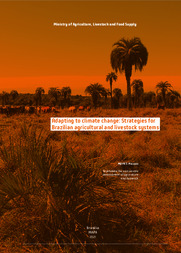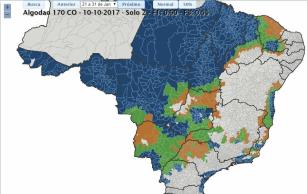Agricultural climate risk zoning (ZARC).
Agricultural climate risk zoning (ZARC).
Author(s): MONTEIRO, J. E. B. de A.; COSTA, F. de S.; BEZERRA, M. A.; COMUNELLO, E.; ZOLIN, C. A.; PEREIRA, J. R.; MELEM JUNIOR, N. J.; ANTONIO, I. C.; SANTIAGO, A. V.; SILVA, S. C. da; SILVA, F. A. M. da; STEINMETZ, S.; KLEPKER, D.; COELHO FILHO, M. A.; CABRAL, O. M. R.; ANDRADE JUNIOR, A. S. de; GUIMARAES, D. P.; SORIANO, B. M. A.; PEZZOPANE, J. R. M.; EVANGELISTA, B. A.; ALVES, A. B.; MOURA, M. S. B. de; FARIAS, J. R. B.; BARROS, A. H. C.; TEIXEIRA, W. G.; SILVA, A. A. G. da; CUNHA, G. R. da; CONCEIÇÃO, M. A. F.; HIGA, R.; PELLEGRINO, G. Q.
Summary: Agricultural Climate Risk Zoning (ZARC) was implemented in 1996 with the objective of delineating municipalities and planting times based on agroclimatic risk. At its base is, a network of researchers and technicians from Embrapa and several other state institutions and an elaborate construction of agrometeorological data analysis systems and mathematical simulations, which quantify the production risk in the normal climatic conditions of each region, in order to allow an adequate assessment of the variability of each location, season and its consequences for agricultural crops.
Publication year: 2021
Types of publication: Book sections
Observation
Some of Embrapa's publications are published as ePub files. To read them, use or download one of the following free software options to your computer or mobile device. Android: Google Play Books; IOS: iBooks; Windows and Linux: Calibre.
Access other publications
Access the Agricultural Research Database (BDPA) to consult Embrapa's full library collection and records.
Visit Embrapa Bookstore to purchase books and other publications sold by Embrapa.


